Hi ! We hope this site helps you! ٩(ˊᗜˋ*)و As an Amazon Associate, we earn from qualifying purchases without additional cost. Click to read more about our Privacy Policy or Affiliate Disclosure
There are more than 1 type of writing in Japanese and Kanji is one of them. To read about the other type of writing and as to why do Japanese need more than 1 type of writing, you could check this article: Japanese Type of Writing.This article will help to answer basic questions about Kanji and effective method to master Kanji within a few months. Well then, let’s start
Things to note before you start the road to master Kanji
If this is the first time you want to learn Japanese, you would not want to learn Kanji first. You should learn Kanji, but it shouldn’t be your first priority. Here’s what you need to learn in the order of priority:
1. Learn Hiragana
2. Basic Japanese such as understanding Japanese type of verbs & adjectives, basic Japanese conjugations, greetings, は particle, and others
3. Learn Katakana
4. Start learning kanji & grammar pattern according to JLPT materials and level up your Japanese skills (use text book reference to help you with the material)
If you’re looking to pass a JLPT test, you could get a list of the kanji & compound word required and only practice the kanji & words within the list.
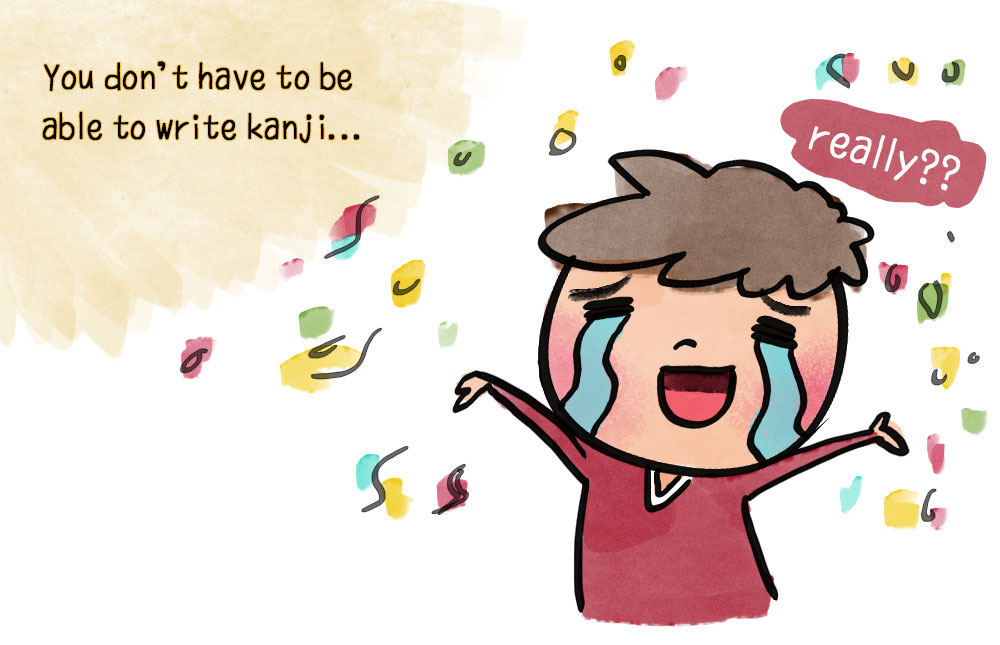
Structure of a Kanji
人
This is a single simple kanji
• Basic meanings: man,people
• Onyomi (Chinese) reading: じん (jin), にん (nin)
• Kunyomi (Japanese) reading: ひと (hito)
Note that there are more than 1 readings for a kanji. So for example, 人 in is read as Jin. While in “どんな
What is Onyomi and Kunyomi reading in a Kanji?
Below you can find the definition of Onyomi and Kunyomi and also how to differentiate when to use the reading on a kanji you found on Japanese sentence.
ONYOMI is Chinese reading and it’s mostly used on nouns/compound words (words with 2 or more kanji) such as:
– 家族 [Kazoku] : Family
– 動物園 [Doubutsuen] : Zoo
While KUNYOMI is Japanese reading and is mostly used on:
– Single kanji such as 空 (Sora) : Sky , 白 (Shiro) : White
– Words with Okurigana (Kana that attached after kanji) such as 新
And also note that the general rules above might not be able to be applied to every case… .Even native people sometimes have a hard time to know what the reading of some words/name at first.
Some kanji even have a special reading. For example 一人 is hitori. It completely ignored the Onyomi and Kunyomi reading.
About Japanese Radical
What is radical? Basically, a complex kanji is made out of a combination of shape. We call these repeated shape “Radicals” or “Kanji building blocks”. Check out the example below:
春
This is kanji means spring, and it’s more complex than previous 人 kanji.
Now if you analyze and break it into part, you can see it’s actually a combination of 三 (three) + 人 (people) + 日 (sun/day)
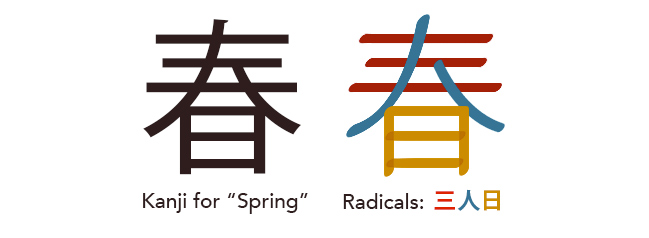
By knowing this fact, remembering/trying to write this kanji is now much more easier! These 3 kanji you saw, we called them radicals/building blocks. And you can check out all the list of 215 radicals shape and meaning with this link here.
Notes about Japanese radical
1. Some radicals combination might make sense, but most of them are not
For example, we have a sample here which make sense. 愛 (love) is a combination of 受 (receive) and 心 (heart). So literally Love is to receive someone’s heart. It’s quite logical right?
*You might have noticed a grey stroke which is not exist in 受 (receive), but don’t mind about where does the grey stroke comes from 😀 In kanji, please treat all general rules with flexibility, since they are not 100%.
But most of the kanji you will encounter will be like the 2nd sample. If you asked “Why?”. We really recommend you for not to sign up for that class… _:(´□`」 ∠):_ Just be aware that you could see a kanji/pure radical in a complex kanji, and use it to aid you with memorization. For example, you could make up a story like “A heavy
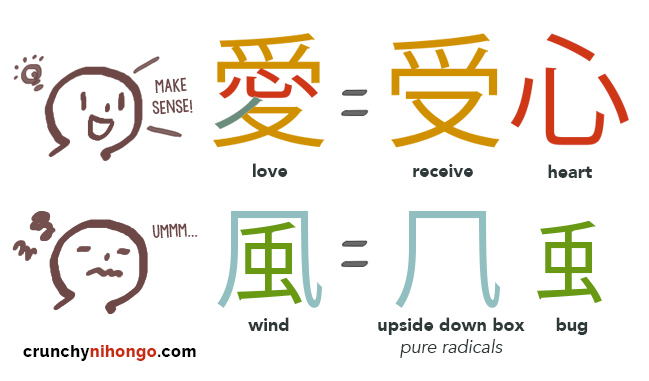
2. Some radicals are a real kanji with meaning, like the kanji for spring we covered. But some of them are PURE radicals. Which means that they are purely building blocks and cannot stand by itself. Some pure radicals have meaning but some don’t. As you can see in the image below, kanji with the same pure radicals usually hold a more/less related meaning. Note that this doesn’t apply to all kanji. But knowing this fact should help you to learn related kanji easier.
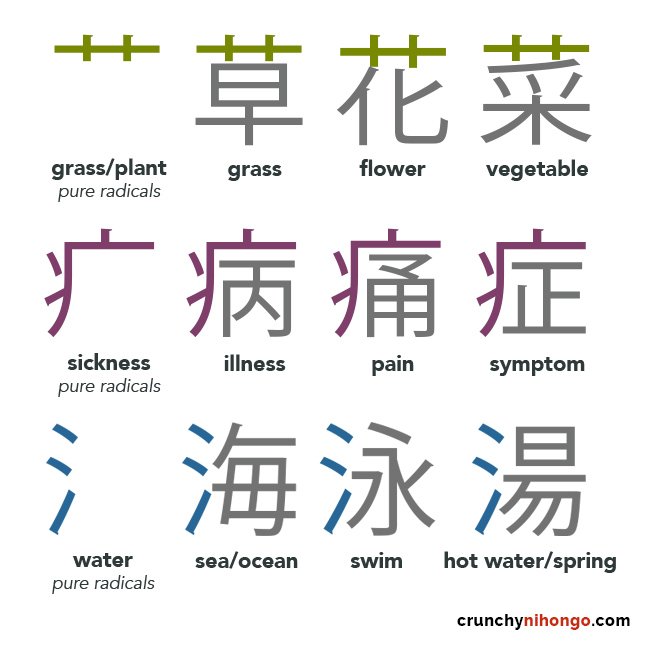
Important Notes About Radicals
For shape which doesn’t have any meaning. You could name it up yourself to help you with your study! In fact, if you think the original radicals name/meaning doesn’t make sense to you, change it up!! There are no rules about radicals. Keep in mind that radicals are there to help you, not to burden you with more things to memorize. So you don’t have to study/memorize all the pure/strange radicals before you learn kanji. Use it only to aid you to memorize a complex kanji.
Japanese Compound Words
Compound words is a combination of Kanji to create a new meaning. We have those in English too! For example football: foot + ball or underworld: under + world.
Things to note about Japanese compound words:
1. Same kanji, different sound. Check out these two compound words 男
2. When combined, usually the first kana of the combined word change sounds into it’s muddied version (kana with mini quote or circle). For example: 花 (flower) is はな (hana). Combined as 火花 (spark), it is ひ
3. In rare occasion, the reading of a compound words might not follow any rules/reading of the kanji. As in 一人 (one people/alone) which is read as
4. In most cases, compound kanji are logical literal words. 三角 (sankaku: triangle) is 3 corners. But some case, it cannot be explained/hard to be explained literally. Here’s one example, 事故 (jiko: accident). 事 is fact/reason/matter/possibly/business/thing. 故 is cause/circumstances/reason/intentionally.
Tips to Learn Kanji
Don’t be afraid to learn Kanji. It seems difficult, but with a proper concept of learning Kanji, it could be quite easy & fun process!
Think of it like this… Learning kanji is like being introduced to a new friend. To differentiate similar shapes of kanji, is similar to differentiate your twin friends.
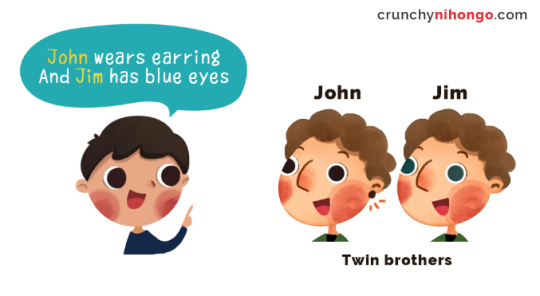

And to know how to read one kanji when it’s being combined with another kanji, is like learning someone’s nickname within a specific circle of friend! John is called Johnnie when he’s with his girl, but may be called Jo by his buddies.
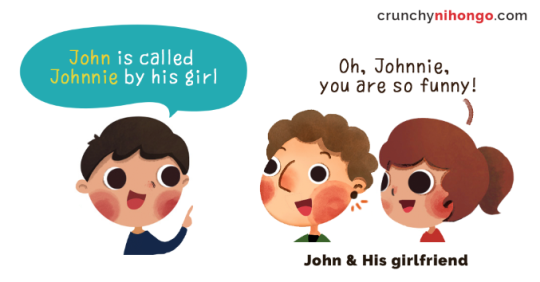
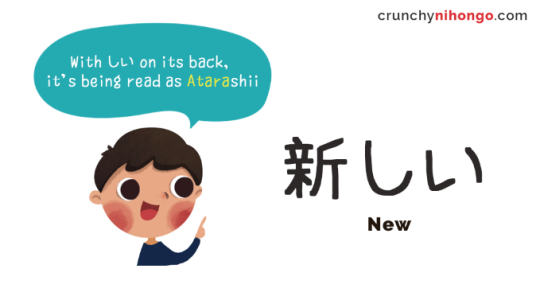
So how do you able to memorize them? The same way as to remember the name/face of your acquaintances. Meet up, interact, and know more about them. Expose yourself to the kanji you want to memorize as much as possible. You won’t remember much about somebody you rarely meet. But you will instantly recognize your best buddies walking gesture even from far! °˖✧◝(⁰▿⁰)◜✧˖°
So basically, best method to acquire kanji is by using them and practice reading them in a lot of sentences. Keep exposing yourself to a specific kanji until it’s very natural for you to read it.
How to learn Kanji?
Purpose: to learn Kanji for JLPT test
1. Get a list of words for JLPT (you could click the link below to get them)
JLPT N5
2. Get offline dictionary for your phone:
IMIWA for apple | Takoboto for android
3. For each entries of words, try to get the sentence examples. You could get it at online dictionary such as Tangorin. Because by reading examples of sentence, you could get a clear meaning of a words & how to use them in a sentence.
4. Get digital flashcard for smartphone:Ankidroid
*Ankidroid is the best and free apps for flashcard builder. For iphone, you could try the FreeAnkiAppFlashcard, Free Brainscape or 25$ AnkiMobile
5. Create a flashcard deck from 1st list. Make sure you read each sentence examples before inputting a word to your deck. Now, the most important thing is:
What you could write on each card:
– Write the conjugated version of the word you found on the book
– Write meaning of each kanji
– Describe the shape of the kanji or it’s radical
– Create a weird sentence (mnemonics) that can relate to some of the word, etc
For example, if you want to memorize 歌手 Kashu: singer.Here are what you can write beside its reading & meaning:
– 歌 uta: song
– 手 te: hand
– Singer hold mike on hand and then sing a song!
– Kardashian Sucks as a singer (Kashu)
Note that as in
6. Review your card everyday, and add new cards when you see fit
Key: Review EVERYDAY. Your brain logic: What you don’t use = junk and need to be erased from database.
The Key of Memorization
Made up a story! Even something that is not true/not make sense/something funny will do!
This is the key to memorization and will help you a lot to learn Kanji.
How many kanji should I learn in a day/month
The real answer is as much as you possible. But we know that this is not what you want to know. So here’s a number… about 70 words/day or 500/10 days if your goal is to master around 70% coverage (4000+ compound words) within 3-4 months. With this amount, JLPT N5 list of words (600 entries) can be done in 10 days or a total of 3 weeks to cover N5-N4 (1500 entries).
But note that everyone have a different capability. So you could try to do around 10/day at first, and if it’s too easy/hard, you could adjust it until you reach a number which you’re comfortable with
ヾ(@°▽°@)ノ
And that’s all you need to know to effectively learn Kanji. If you would like to achieve 70% kanji reading coverage, we recommend you to read this article here: Mastering Kanji in 4 months. Note that it’s best for you to learn JLPT N5 – JLPT N3 first before starting the 70% coverage route.
Well then, Happy learning! 。゚✶ฺ.ヽ(*´∀`*)ノ.✶゚ฺ。

You put a lot of effort into this blog. I love every post, it’s so different from other blogs with the same topics. That’s why I really appreciate it, the way you introduce new students into kanji/kana/books… Is SO original and useful. I personally loved the comparison between kanji’s lectures and people’s names according to the context. Now, I’ll stop being a fan but I clearly made myself one by learning with all your amazing posts! Pd. I’m not fluent at English so すみません for all my mistakes
Your English is just great and understandable! And isn’t that all that matter when it comes to language? 😉
Thanks for letting us know and explain why you like our posts. It means a lot to us! *big hug*!